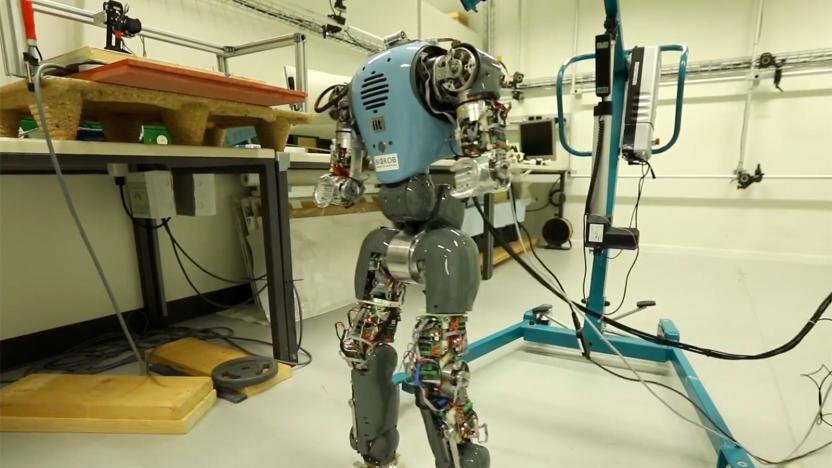EcolePolytechniqueFederaleDeLausanne
Latest

These tiny drones can lift 40 times their own weight
If you ask these tiny drones, "Do you even lift, bro?" you will get a resounding yes. Researchers at Ecole Polytechnique Fédérale de Lausanne (EPFL) in Switzerland and Stanford University have developed a line of small flying bots that can move objects that are 40 times their weight.

Virtual reality could be the answer to treating phantom pain
People who become paraplegics due to a spinal injury usually have to deal with more than just losing the feeling in their legs. They also have to battle excruciating phantom pain, which doctors can't cure with medicine. Now, scientists from the École polytechnique fédérale de Lausanne (EPFL) have found a way to alleviate the pain they feel using a pair of fake legs and the magic of immersive virtual reality.

Robots learn to walk naturally by understanding their bodies
The challenge with bipedal robots isn't so much getting them to walk at all (although that's sometimes a problem) as it is getting them to walk naturally. They tend to either step cautiously or quickly run into trouble. Swiss researchers think they can do better, though: they're working on COMAN (Compliant Humanoid), a headless robot designed to master walking. The automaton is more graceful through a combination of more flexible, elastic joints and a control algorithm that helps the bot understand its own body.

Algorithm shows the data you give away when clicking suggested links
If you're roaming the internet, you might run across recommendation engines. Some offer products or services you'd actually want to use, but does interacting with them harm your privacy even more? Researchers developed an algorithm to reveal how much info you're handing over when you click around, essentially picking out which parts of a recommendation engine are and aren't safe for privacy-minded users.

Mind-controlled robot gives the disabled a taste of home
Brain-controlled robot limbs have already helped the disabled gain some mobility, but full-fledged robots have proven elusive: how do you use thoughts to steer a free-roaming machine? Swiss researchers think they have the answer. They've developed a mind-controlled telepresence robot that lets those with motor disabilities travel when it would otherwise be impractical. It's ultimately a laptop on a pedestal, but it uses clever semi-autonomous software to take the hard work out of controlling where the robot goes. You only have to don an EEG-based cap and imagine moving your hands or feet -- the robot plots a path based on your commands, and avoids obstacles all on its own.

Flexible spinal cord implants will let paralyzed people walk
Doctors dream of helping the paralzyed walk through implants that stimulate their spinal cords, but current technology makes that impossible; these stiff, unnatural gadgets usually end up damaging or inflaming nervous tissue over time. Swiss researchers may have just solved this problem once and for all, though. Their bendy e-Dura implant combines flexible electrodes (made of platinum and silicon microbeads), cracked gold electronic tracks and fluidic microchannels to deliver both electrical impulses and chemicals while mimicking the spine's movements and avoiding friction. Paralyzed rats in lab tests could both walk again after a few weeks and keep wearing their implants after two months.

Scientists build a robot arm that catches objects in the blink of an eye
Humans are good at catching fast-moving objects -- just ask any baseball fan. Robots typically lag behind, however, which is why the École Polytechnique Fédérale de Lausanne (EPFL) has developed a robot arm with the reaction time needed to catch just about anything. After learning the basic concepts by imitating human behavior, the machine uses its cameras to predict the path of a flying object and grab it in less than five hundredths of a second -- roughly as fast as it takes you to blink. It can even adapt to objects whose center of gravity is likely to shift around, such as a half-full drink bottle.

EPFL mixes graphene and molybdenite to make very efficient, flexible flash memory
We've seen graphene chips, and we've seen molybdenite chips. What would happen if we combined the two? If EPFL's experimental flash memory is any clue, we might get one of the better blends since chocolate met peanut butter. The chip uses graphene's high conductivity for the memory itself, as well as for electrodes, but stuffs molybdenite in between to rapidly switch electrical states (such as what you'd see in write commands) while using little power. The hybrid is theoretically both faster and more power-efficient than conventional silicon designs, but that's just the start: the extra-thin nature of either material is better-suited to flexible electronics on top of shrinking the chip footprint. If there's anything at this stage that would sour EPFL's dreams of a storage utopia, it's time. There's no immediate mention of commercialization plans for the mutant memory, which could leave us stuck on silicon for awhile.

Swiss bionic hand offers true sensations through the nervous system
Those wearing bionic hands and similar prostheses often suffer a frustrating disconnect when they can touch an object but can't feel it, even if they're using direct neural control. The École Polytechnique Fédérale de Lausanne and allies in Project TIME have developed a hand that could clear that psychological hurdle. The design implants electrodes directly in key nerves that not only allow motor input, but deliver real sensory feedback from the artificial appendage -- including needle pokes, much to the test subject's chagrin. An early trial (seen above) kept the enhanced hand separate from the wearer and was limited to two sensations at once, but an upcoming trial will graft the hand on to a tester's arm for a month, with sensations coming from across much of the simulated hand. EPFL hopes to have a fully workable unit ready to test in two years' time, which likely can't come soon enough for amputees wanting more authentic physical contact.



